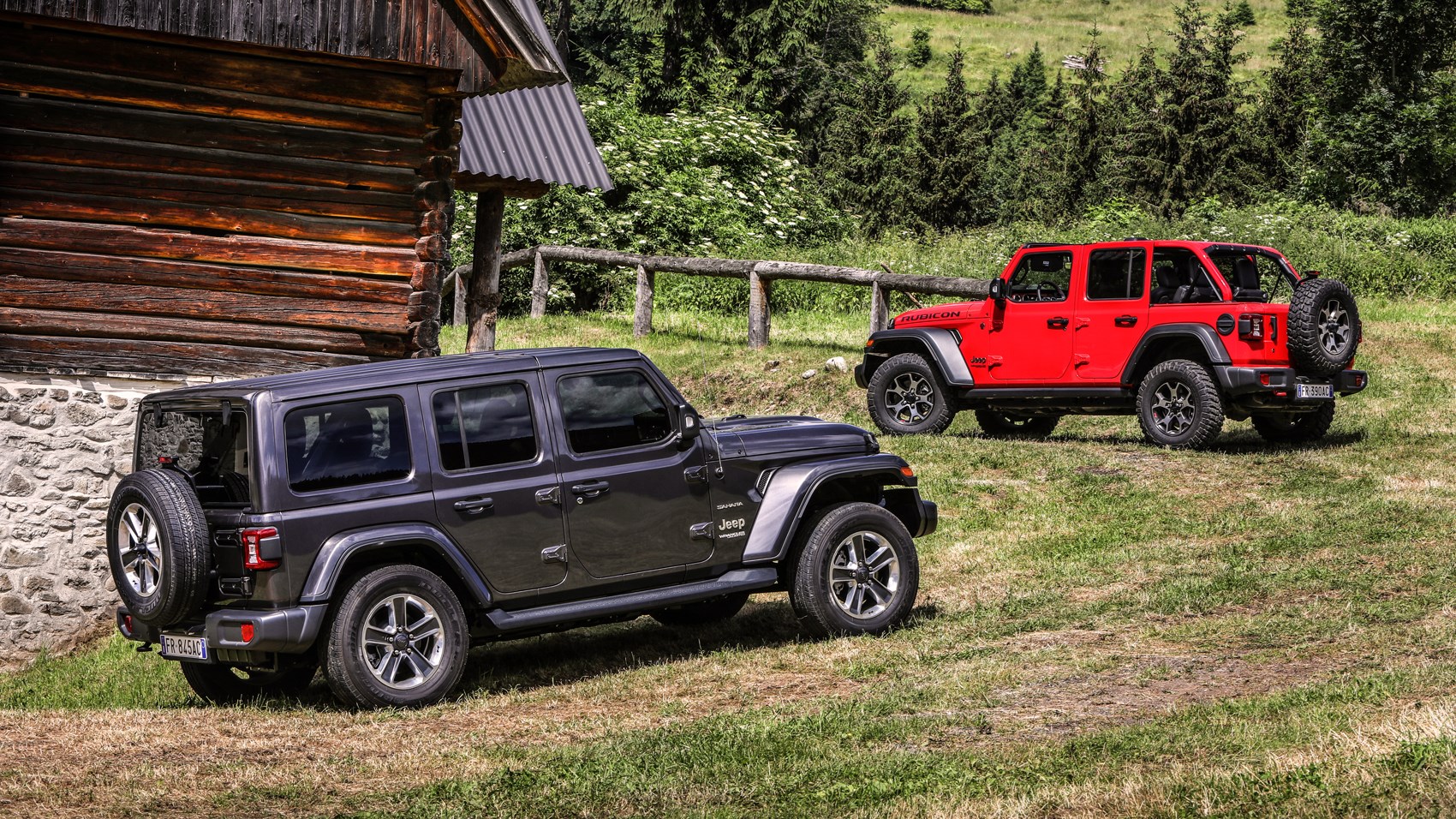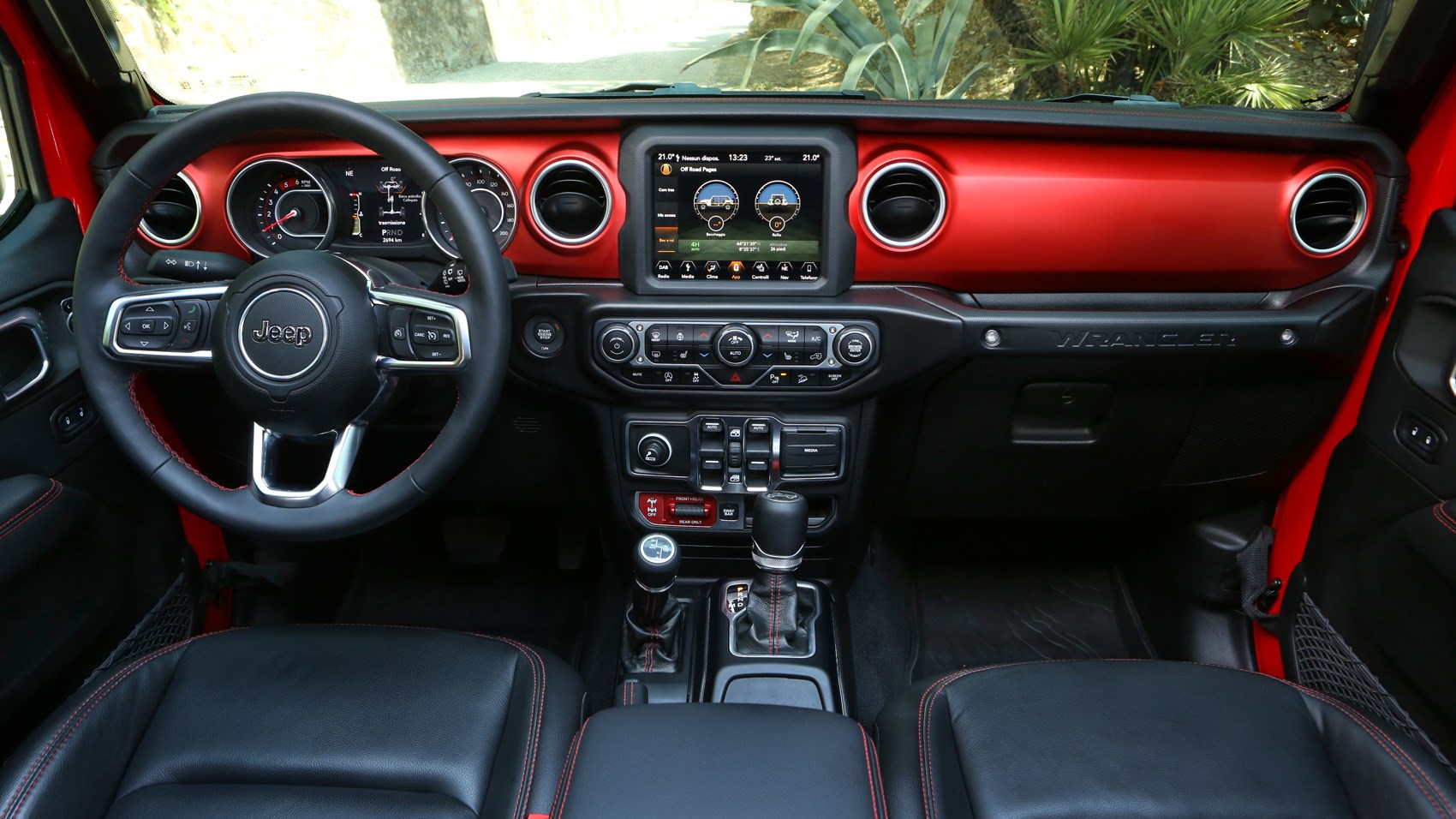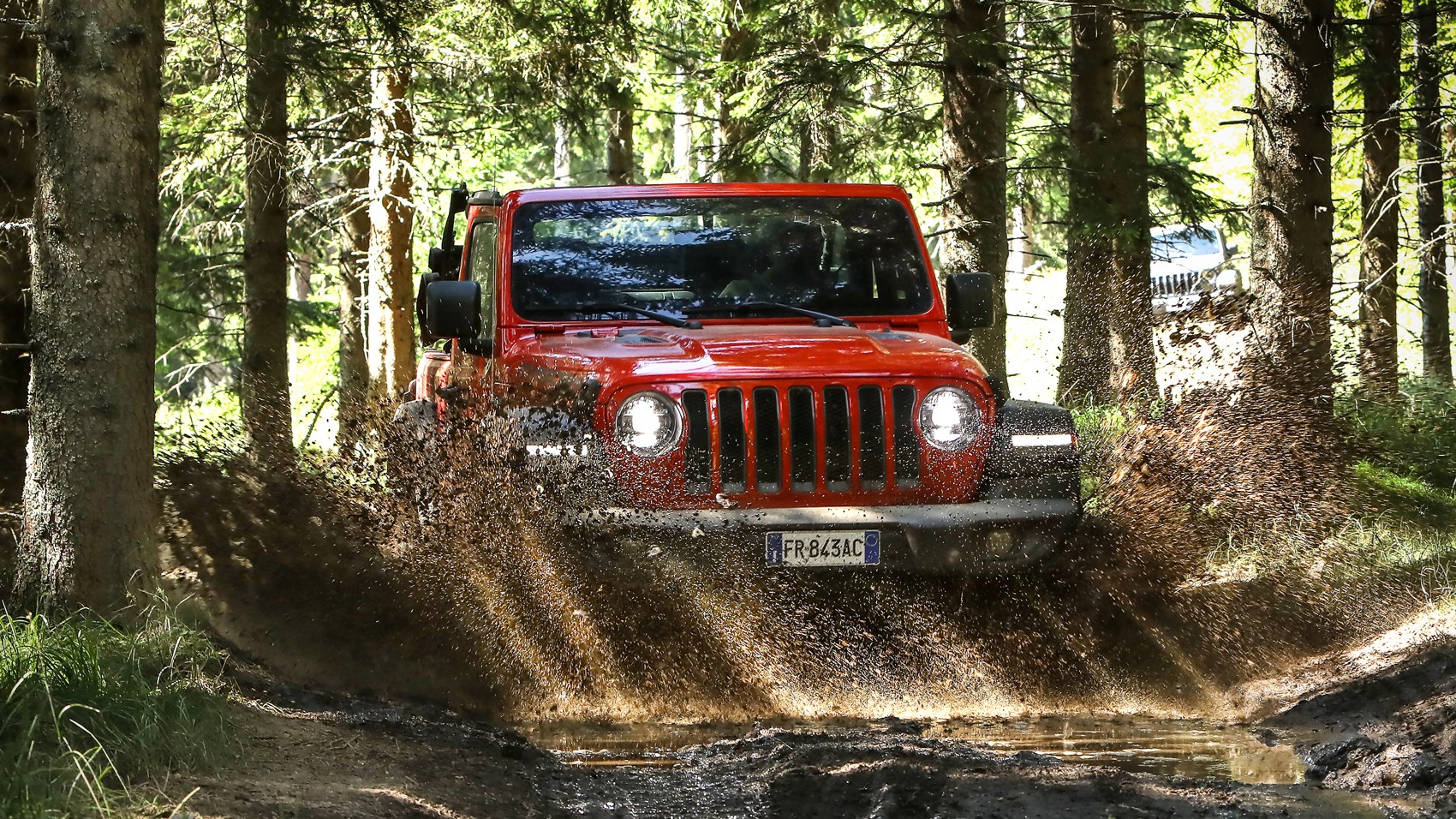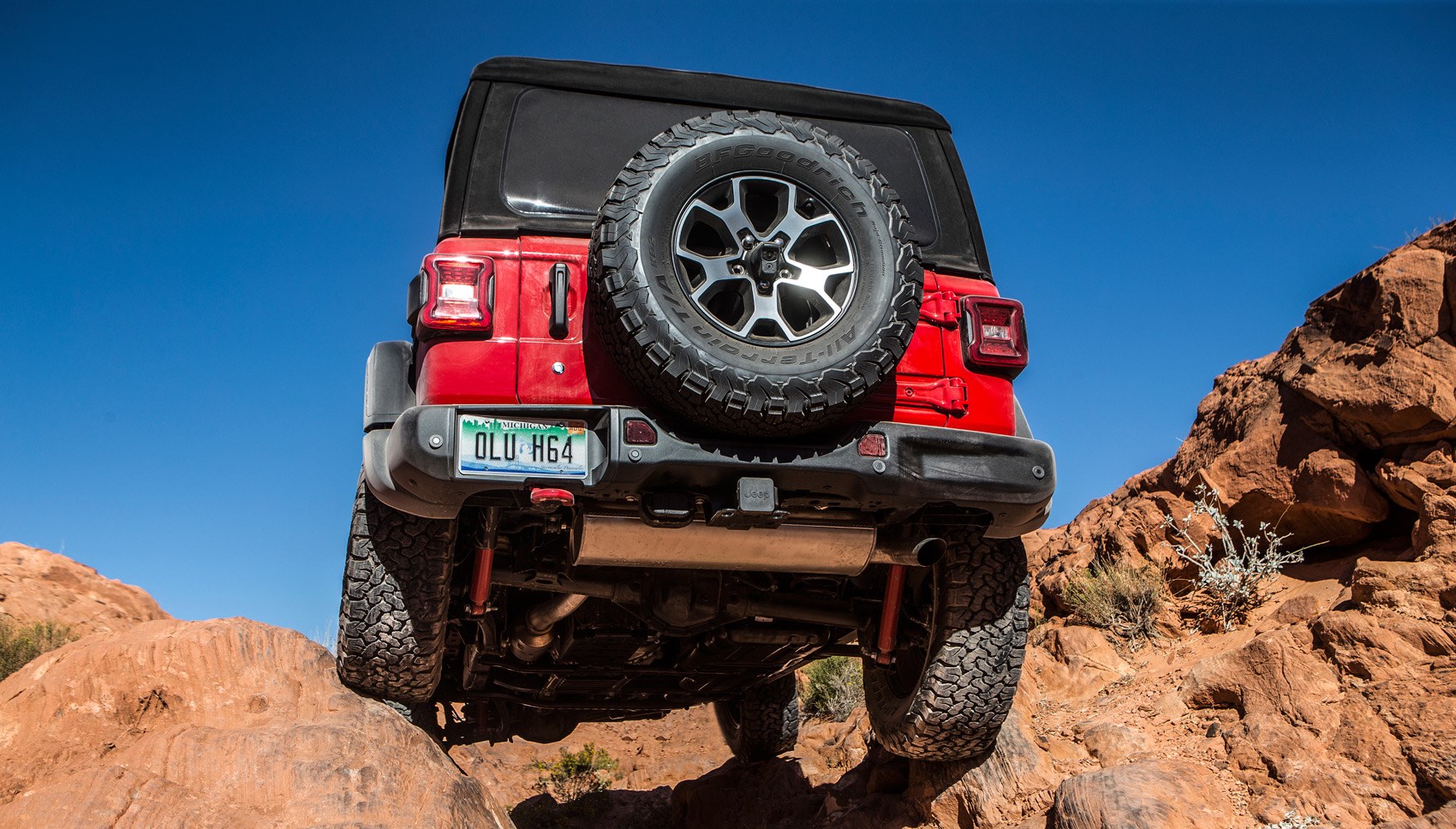► Wrangler driven on and off-road
► Even more capable off, comfier on
► On sale now in UK from £44,495
A new Jeep Wrangler is a rare event. The previous generation was last driven in 2006 on this website, and was rarely driven since then in CAR magazine. Things really do happen at a snail’s pace in Wrangler world.
But then it would when the long-running model has roots tracing right back to the 1940s CJ series, which even then came from the original wartime Willys Jeep. So here’s the new 2018 Jeep Wrangler JL – the latest version of the brand’s go-anywhere, have-fun-getting-there adventure plaything. The characterful looks remain, but there’s a lot of changes inside and underneath.
Give me a quick Jeep Wrangler JL need-to-know checklist
- This is the fourth Jeep Wrangler generation (called the JL series, model codename fans – it succeeds the 2007 JK series)
- Available with two doors or four (and two wheelbases)
- Choice of three roofs: the Sunrider soft top, a three-piece modular hardtop, or a power-top motorised canvas roof (the latter will join the range in 2019)
- Removeable doors, as before, now designed to be quicker to remove and easier to carry.
- Windscreen can still be dropped flat for the full wind-hair interface; now takes fewer bolts to remove
- Choice of two engines in Europe: 2.2-litre Multijet II turbodiesel or 2.0-litre turbo petrol engine. There’s also a 3.6-litre V6, but not for European markets
- All have an eight-speed auto gearbox
- Plug-in hybrid version on the way in 2020
- Went on sale from September 2018
Are you sure this is the new Wrangler? It looks kind of similar to the old one…
Which, of course, is the point. Like a new Mini or 911, Jeep’s designers have sensibly played safe with the shape, keeping a full house of established design cues from the Wrangler family tree.
Its recognise-you-anywhere face now features adaptive full LED headlights by Magnetti Marelli, bookending the familiar seven-bar grille cut-outs (now with a more canted upper section, difference-spotters). The rest of the Wrangler hallmarks are all there – spare tyre, separate bumper and outboard wheelarches with angles echoing those of the original Willys.

This time, however, the Wrangler’s brief is to appeal as much to urban, metropolitan customers as to full-time outdoor adventurers, and to convert more first-time Jeep customers from other brands.
Hence an increased emphasis on comfort and refinement, but without any shirking of off-road ability. It’s now a tad quieter and comfier on tarmac but the Wrangler is still very much an off-road-oriented machine.
A countless number of accessories, both visual and mechanical, make this one of the most customisable Jeeps ever, too.
How much is the new Jeep Wrangler?
Two-door and four-door models are available. UK prices start from just under £45,000; that’s not cheap, with the price nudging £50,000 if you want a four-door Rubicon with a power-folding roof. The model range shapes up like this:
- Sahara – The base spec in the UK and the most on-road-focused version
- Overland – In Europe it’s an option pack, in the UK it’s a slightly more luxurious middling trim
- Rubicon – The most off-road focused version, with all-terrain tyres and uprated drivetrain components
What’s the new Jeep Wrangler interior like?
It’s a more luxurious environment than the previous JK model, with new, more ‘premium’ materials, including a wrapped upper dash surface with stitching, rubber over-moulding across many of the touchpoints and a new centre console design with more intuitive switchgear.
The controls and ergonomics feel well-resolved on the whole, and decent-quality too. Interior materials strike a balance between soft-touch-comfort and hard-wearing durability.

The steering wheel is still gigantic, there are grab-handles galore for off-roading and the mix of horizontal and trapezoidal lines are a link to classic MB and CJ-series Jeeps but it’s the most modern-feeling Wrangler yet, with a choice of three ‘Uconnect’ touchscreens (in 5-, 7- or 8.4-inch diameters) with pinch-to-zoom maps and Apple CarPlay/Android Auto compatibility and a separate new digital display screen within the instrument cluster.
Four-door Wranglers have a considerably longer wheelbase and are genuinely roomy for rear passengers, who get their own air-con vents and dual USB points. Boot space (accessed via a side-hinged tailgate and swing-up rear window) is poky with the rear seats in place, however, and you’ll need to drop them to carry more than a few small bags.
Sitting within the Wrangler is a little bit like sitting within an exoskeleton; the rollover structure is on display, and the stereo’s speakers are sited within it, rather than in the removeable doors.
What’s it like on the road?
In many ways the new Wrangler really is genuinely refined on the road. The 2.2-litre turbodiesel is far quieter than in previous models, at a standstill and at a cruise, and wind noise is reasonably well-supressed for a bluff-nosed, square-mirrored vehicle, even in soft-top versions. Unlike many hardy 4x4s, you won’t need to raise your voice to have a conversation with a passenger at motorway speeds.
The diesel engine is smooth and reasonably flexible, and the standard eight-speed automatic gearbox feels well-calibrated.

Rubicon versions wear chunky off-road tyres, which hum and whir like a London Underground train as speed builds and make the steering less than precise. Feedback is conspicuous by its absence, and at first you’ll be sawing at the wheel even while travelling in a straight line. Turn into a corner and the amount of steering input doesn’t necessarily reflect the direction of travel, as the treadblocks go one way and the car goes another. But you quickly become used to it.
Handling on the Sahara-spec car’s more conventional tyres is a little more precise, although the Wrangler is still a car best driven at a leisurely pace.
And what’s it like off it?
We drove a Sahara-spec Wrangler on normal tyres on an off-road trail that is relatively tame by Wrangler standards, but which would have been uncrossable in a regular car: steep climbs, big rocks, tree roots and deep ruts, all made slippery by rain. It handled it all with ease.
The new Wrangler has greater ground clearance, improved crawling performance, shorter overhangs for improved approach and breakover angles and is capable of 760mm water-fording depth. Even the doors’ corners have been altered, to make drivers less likely to bash them into obstacles when opening them on slopes.

Two active four-wheel-drive systems are available, dubbed Command-Trac (on Sport and Sahara versions) and Rock-Trac (on the Rubicon version). Both feature a two-speed transfer case to manage the amount of torque sent to the front and rear. Rock-Trac has a lower ‘low-range’ ratio, and tougher axles with front and rear axle locks as standard.
A new digital display screen on the instrument panel – also by Magnetti Marelli – gives you an at-a-glance view of what the transfer case is up to, and the main touchscreen includes off-road pages detailing pitch, roll and altitude.
A smaller secondary gearlever switches between 2H (two-wheel drive high range), 4H Auto (on-demand 4WD, high range), 4H part-time and 4L (4WD low range).
Unlike previous Wranglers, it’s now possible to shift from 2WD to high-range 4WD at up to 47mph.
As well as electric front and rear axle locks, the Rubicon version also features an electronic disconnect for the front anti-roll bar, enabling even greater angles of dangle for the front wheels to get over rocks, boulders and generally lumpy terrain.
Oh come on, surely you’ve tried tougher terrain?
During our visit to the 2018 SEMA show, some time was also spent on a challenging rocky trail in the Valley of Fire in Nevada, allowing us to really get to grips with the proper rough-and-ready Rubicon model. While the first test of the Wrangler was about wet mud and hilly forests, the dry and rocky desert of the Western USA was a welcome challenge.
Our Wrangler was a four-door Rubicon with the 2.0-litre petrol engine and the trail was slow, rocky and included some inclines that we’re sure had more than 100% gradients. We made full use of the electronically disconnecting front roll bar and axle locks for greater off-road flexibility.

Almost every part of the trail was made up of daunting drops, narrow gorges and plenty of opportunities to ground out the Wrangler, but the Jeep’s ability to keep itself from rolling over or getting stuck was confidence-inspiring and pretty entertaining.
And even when we got a little aggressive and careless with certain parts of the trail, the Wrangler shrugged it off like water off a duck’s back. It’s that kind of car.
Verdict
In a world where almost every new car is trying to look like an SUV, the Wrangler remains an authentic original, and an immensely likeable one.
While it is genuinely refined at a cruise, its off-road focus still makes it a compromised proposition on tarmac compared with more mainstream 4x4s. For an urbanite who plans the occasional off-road adventure it might be just about comfortable enough to live with through the rest of the year, but ultimately the Wrangler remains a car best-suited to people who will use it as intended – off-road.
If a sports car is designed to be fun to spend time roof-down on a winding road in the sunshine with friends and as a design object to look at and geek over, so is the Wrangler – but substituting B-road for rocky trail. If the previous Wrangler wasn’t for you, the new one’s uprated refinement probably won’t quite be enough to sway you. If you loved the old one, the new one stays true to the formula while making useful strides forward in key areas of refinement, economy and safety.
Check out our Jeep reviews
